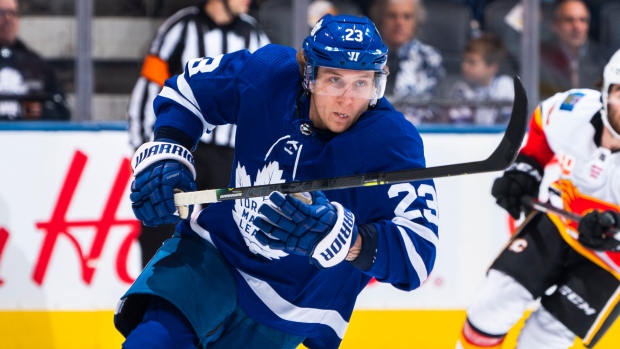Dec 31, 2021
Dermott deserves a longer look on Leafs blueline
The blueliner has seen somewhat sheltered minutes in his time with Toronto, but there is no question his on-ice awareness and skating ability make him a useful weapon behind Leafs attackers, Travis Yost writes.
By Travis Yost

If the Toronto Maple Leafs are to take a step forward this season, a lot of it will stem from performance gains made in the defensive zone. A lot of that burden will fall on the blueline – a blueline that was significantly revamped in the off-season.
Most of the attention and scrutiny will fall on T.J. Brodie, the veteran who landed a four-year, $20-million dollar contract to anchor the team’s top pairing through 2023-24. Brodie is a versatile two-way defenceman and immediately becomes one of the all-Canadian division’s best on the right side. He will absorb the minutes vacated by the likes of the departed Tyson Barrie and Cody Ceci.
Brodie’s presence – along with the recent additions of Zach Bogosian and Mikko Lehtonen, plus prospect Rasmus Sandin – gives head coach Sheldon Keefe much more optionality with his lineup heading into this season. But perhaps the most interesting question concerns fourth-year professional Travis Dermott, and what the Maple Leafs may be able to squeeze from the 24-year-old.
Dermott will be one of the many faces competing for bottom-four minutes, but I think it’s reasonable to say he has a leg up on the competition right now. General manager Kyle Dubas has indicated an interest in playing Dermott on his off-side, which would keep him as a regular in the lineup, likely playing alongside one of Jake Muzzin or Lehtonen.
There is good reason to keep Dermott in the Maple Leafs lineup. Though he’s seen somewhat sheltered minutes in his time with Toronto, there is no question his on-ice awareness and skating ability make him a useful weapon behind Maple Leafs attackers.
In fact, since Dermott’s entered the league, it’s hard to find another rostered Toronto defender with better on-ice results:
One of the key points that I come back to when a defender has a unique attribute – perhaps he is great at creating offence; perhaps he is strong at suppressing offence against – is whether or not his team is getting positive results with the player on the ice.
Barrie and Ceci, as two obvious examples, were brought in partially because of their ability to transition pucks and create a second level of attack. But even when Barrie and Ceci were creating that second level, it never meant much. They were far too mistake-prone – often losing pucks in transition through the neutral zone, or being beaten back into the most dangerous areas of the defensive zone where mistakes can be fatal. Ultimately, their offensive contributions couldn’t outpace their defensive futility, and team performance suffered.
That is where Dermott becomes an interesting case. The team has used him more sparingly than others, but there is no doubt that the Maple Leafs are playing on the right side of the ice on most nights when Dermott’s pairing is deployed.
Looking just at 5-on-5 play over the past three seasons, the Maple Leafs have realized the following in Dermott’s 2,439 minutes:
- A +281 shot advantage
- A +14 expected goal advantage
- A +25 actual goal advantage
It is true that Dermott’s had a little more puck luck than the average Maple Leafs defender, but some of Toronto’s goaltending success with Dermott on the ice really is about maintaining defensive structure. Dermott’s playing against weaker attackers than a player like Morgan Rielly, but he’s also working hard to shed his reputation as a defender who needs this type of sheltering.
Looking just at last year’s defensive shot profiles (courtesy HockeyViz), attackers were routinely pushed further out from goaltender Frederik Andersen and towards the half walls with Dermott’s pairing on the ice. In the minutes where the other pairings – commonly Rielly with Ceci, and Muzzin with Justin Holl – were on the ice, teams funnelled their offence right into the Maple Leafs crease:
This is a pivotal season for Dermott. His one-year extension will lapse at year end, and if the league economics turn in the right direction, it’s possible he’ll be positioned for a top-four payday from interested suitors.
For the Maple Leafs, Dermott’s been a solid low-cost option for a few years now – a low-cost option that may not be available starting in 2021-22. Right now, they’ll settle on getting another year of increased production from the Newmarket, Ont., native.
Another developmental step forward could help bury the horrors of last year’s woeful defensive performances and put Toronto in position to win a division title for the first time since 1999-00.
Data via Natural Stat Trick, Evolving Hockey, HockeyViz

